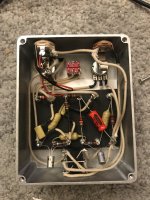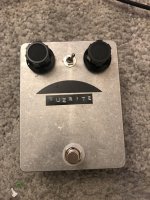andare
Well-known member
- Build Rating
- 3.00 star(s)
I'm on a Germanium kick so here's a Fuzzrite. All stock, Q1 has a gain of about 80, Q2 is around 40. This way the CCW setting on the Depth knob is beefy and the CW setting is not too over the top. Housed in a really nice vintage blue 1590BBS from Banzai.
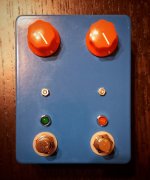
This is me after 4.5 hours of trying to be neat with the wiring...
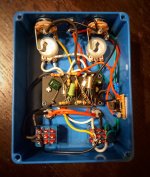
And this is the layout I put together. 100% stock with the addition of a 10nF cap to ground at the input to tame the hiss:
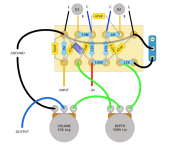
I put the 22k resistor on a footswitch so I could boost the bass. With a tube amp, volume is pretty much consistent but with a SS amp or an interface, switching out the resistor also increases volume.
This circuit barely gets to unity, especially with the 22k at the end. Without it it sounds very generic. The limited cleanup can also be useful. This is a noisy circuit but nothing else sounds like it.
This early Germanium version sounds like a better version of its Silicon brother.
Silicon fuzz is a watery soup with few ingredients and too many bird's eye chilies. Germanium fuzz is a thick soup with a deep, complex flavor, many ingredients and fruity Habaneros.
This is the first build where I implemented a voltage inverter board - I hate making these on stripboard, I want to learn how to design PCBs so I can make voltage inverter PCBs.
Things I learned:

This is me after 4.5 hours of trying to be neat with the wiring...

And this is the layout I put together. 100% stock with the addition of a 10nF cap to ground at the input to tame the hiss:

I put the 22k resistor on a footswitch so I could boost the bass. With a tube amp, volume is pretty much consistent but with a SS amp or an interface, switching out the resistor also increases volume.
This circuit barely gets to unity, especially with the 22k at the end. Without it it sounds very generic. The limited cleanup can also be useful. This is a noisy circuit but nothing else sounds like it.
This early Germanium version sounds like a better version of its Silicon brother.
Silicon fuzz is a watery soup with few ingredients and too many bird's eye chilies. Germanium fuzz is a thick soup with a deep, complex flavor, many ingredients and fruity Habaneros.
This is the first build where I implemented a voltage inverter board - I hate making these on stripboard, I want to learn how to design PCBs so I can make voltage inverter PCBs.
Things I learned:
- DOH! #1: ground is essentially 0V so it can be shared anywhere inside the pedal, regardless of the voltage inverter
- DOH! #2: resistor and capacitor types don't seem to make any difference to the sound
- Everything is so damn tiny: the lugs on the power jack, the lugs on the footswitches, the holes in stripboard, the legs of LEDs. I hate it!
- I don't know how to tin wires or splice resistors to LEDs
- I'm sloooooow
- I shouldn't quit my day job yet


